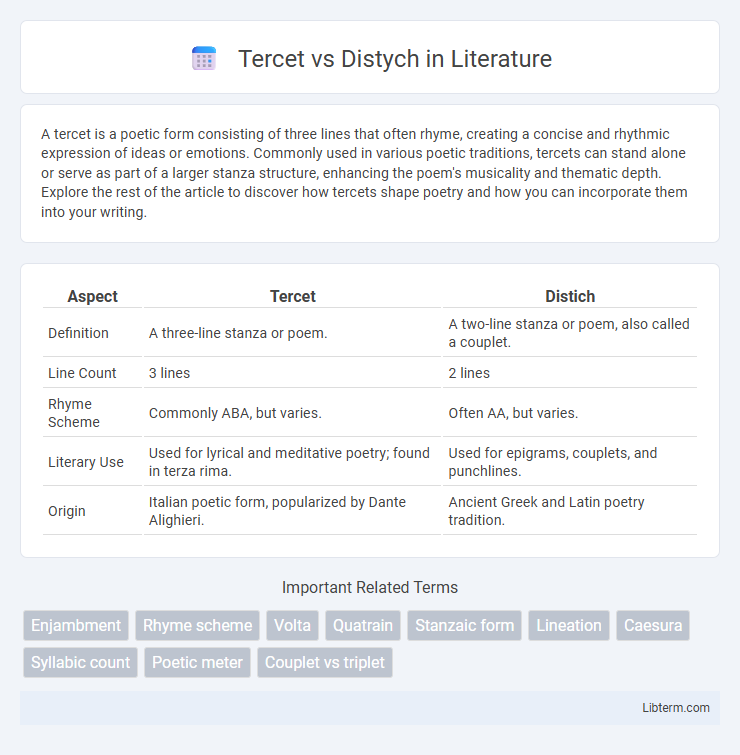A tercet is a poetic form consisting of three lines that often rhyme, creating a concise and rhythmic expression of ideas or emotions. Commonly used in various poetic traditions, tercets can stand alone or serve as part of a larger stanza structure, enhancing the poem's musicality and thematic depth. Explore the rest of the article to discover how tercets shape poetry and how you can incorporate them into your writing.
Table of Comparison
| Aspect | Tercet | Distich |
|---|---|---|
| Definition | A three-line stanza or poem. | A two-line stanza or poem, also called a couplet. |
| Line Count | 3 lines | 2 lines |
| Rhyme Scheme | Commonly ABA, but varies. | Often AA, but varies. |
| Literary Use | Used for lyrical and meditative poetry; found in terza rima. | Used for epigrams, couplets, and punchlines. |
| Origin | Italian poetic form, popularized by Dante Alighieri. | Ancient Greek and Latin poetry tradition. |
Introduction to Tercet and Distych
Tercets consist of three lines per stanza, often employing a rhyme scheme like ABA or AAA to create rhythmic and thematic cohesion in poetry. Distichs, also known as couplets, contain two lines that usually rhyme, forming a concise and impactful poetic unit often used for epigrams or aphorisms. Understanding the structural differences between tercets and distichs enhances appreciation of their unique rhythmic patterns and literary functions.
Definition of Tercet
A tercet is a three-line stanza or poem, often featuring a rhyme scheme such as AAA or ABA, creating rhythmic unity and enhancing thematic expression. Distinct from a distych, which consists of only two lines, a tercet allows for more complex ideas within its compact structure, commonly employed in forms like terza rima. The tercet's versatility makes it a fundamental unit in both classical and contemporary poetry, offering balanced rhythmic and semantic possibilities.
Definition of Distych
A distych is a poetic form consisting of two lines or verses that often function as a complete thought or epigram, contrasting with a tercet, which contains three lines. Distychs are commonly used in classical poetry and epitaphs, emphasizing brevity and impact through concise expression. This two-line structure allows for a sharp, memorable statement or reflection.
Key Structural Differences
Tercets consist of three lines often linked by a rhyme scheme such as ABA, creating a compact and rhythmic unit, while distichs are composed of two lines that may rhyme or stand independently, emphasizing brevity and balance. The tercet's triple-line format allows for expanded thematic development and complex rhyme patterns, whereas distichs rely on dual-line simplicity to deliver concise, impactful statements. The structural distinction influences the pacing and tone in poetry, with tercets offering a more elaborate progression and distichs providing sharp, memorable endings.
Historical Origins and Evolution
The tercet, a three-line stanza structure, originated in Italian poetry during the Middle Ages, notably popularized by Dante Alighieri's "Divine Comedy" with its use of terza rima, which interlocks tercets through a rhyme scheme. The distich, a two-line unit or couplet, has ancient roots in classical Greek and Latin poetry, such as the elegiac couplets used by poets like Ovid and Propertius, evolving later into various European poetic traditions. Over centuries, tercets and distichs have influenced distinct poetic forms, with tercets emphasizing interconnected rhymes and narrative flow while distichs often deliver concise, aphoristic statements.
Usage in Classical and Modern Poetry
Tercets and distichs serve distinct roles in classical and modern poetry, with tercets typically appearing as three-line stanzas that emphasize rhyme and rhythmic patterns, often used in terza rima or haiku forms. Distichs, or two-line stanzas, are prevalent in epigrams, couplets, and elegiac couplets, providing concise expression or thematic closure. Modern poets experiment with both forms to balance brevity and musicality, leveraging tercets for narrative flow and distichs for impactful emphasis.
Artistic Effects and Stylistic Purposes
Tercets, consisting of three lines, create rhythmic complexity and emphasize thematic progression through interlocking rhymes, enhancing lyrical intensity and emotional depth. Distichs, or couplets, provide concise, impactful expressions with strong closure, often used to deliver aphorisms or highlight contrasts for dramatic effect. The choice between tercet and distich shapes the poem's pacing and mood, influencing the reader's engagement and interpretive resonance.
Famous Examples of Tercets
Tercets are three-line stanzas often found in poetry, such as Dante Alighieri's "Divine Comedy," where the terza rima rhyme scheme (aba, bcb, cdc) is famously employed. In contrast, distichs consist of two-line stanzas or couplets, commonly seen in classical epigrams and elegiac couplets used by poets like Horace. The terza rima's interlocking rhymes create a flowing, interconnected structure, making tercets distinct and memorable in literary history.
Notable Distychs in Literature
Notable distichs in literature often showcase profound meaning within their concise two-line structure, such as the elegiac couplets composed by Propertius in Latin poetry or the famous two-line epigrams of Martial. Distichs contrast with tercets by emphasizing brevity and encapsulation of ideas in pairs, enhancing memorability and impact. These succinct poetic units have been instrumental in epigrammatic traditions and classical meters, distinguishing themselves through their balanced and symmetrical form.
Choosing Between Tercet and Distych in Writing
Choosing between a tercet and a distych in writing depends on the desired rhythm and brevity; a tercet, consisting of three lines, offers a compact yet flexible structure for developing a single idea with varied rhyme schemes. A distych, or couplet, with its two-line format, provides a punchy, concise expression often used for aphorisms or conclusions. Writers prioritize tercets when building narrative depth, while distychs suit sharp, memorable statements in poetry or epigrams.
Tercet Infographic

 libterm.com
libterm.com